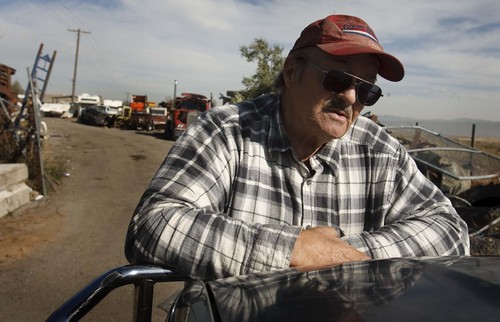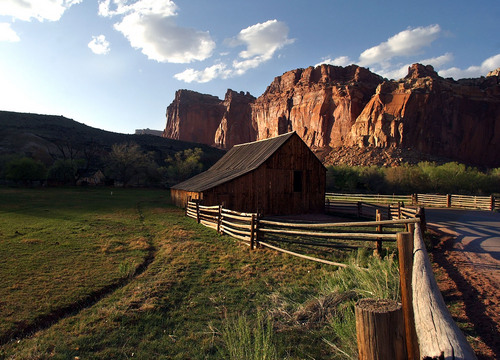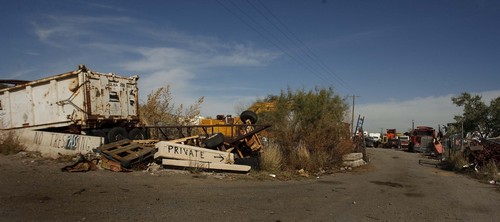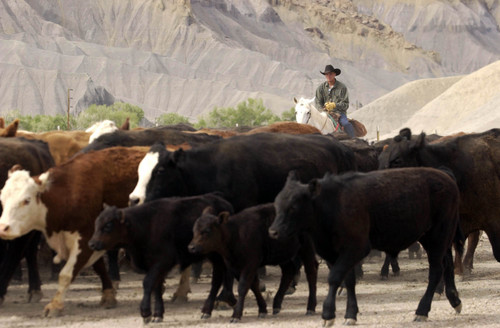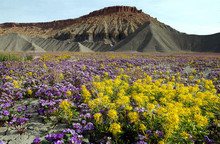This is an archived article that was published on sltrib.com in 2014, and information in the article may be outdated. It is provided only for personal research purposes and may not be reprinted.
Final property tax notices now arriving naturally make many people sad. But some have more reason than others to be down. Their taxes are going up — in some cases, way up.
Take, for instance:
• Castle Valley residents. The town of 330 residents in Grand County raised taxes by $112 on a $210,000 home, up 86 percent. That is the highest tax hike by dollar amount of any of Utah's 600 local governments and districts.
• Folks in the Upper Sevier River Water Conservancy District. It raised its property taxes by 488 percent, the state's highest by percentage. The dollar amount, however, is a small $19 on a $210,000 home. The district says the tax bump is part of efforts that actually lower overall taxes. More on that later.
• Property owners in western Salt Lake City. A tiny area there — filled mostly with dumps and industrial businesses near 7200 West and 2100 South — has Utah's highest total property tax bill coming not only from the city, but also the county, a school district and numerous special districts: $2,199 on a $210,000 home.
That is 3.6 times higher than in unincorporated Wayne County, home of the state's lowest property tax at $616 on a $210,000 home.
—
How many are raising taxes? • This year, 37 local governments in Utah raised property taxes, according to data obtained from the state Tax Commission.
That's down from the 42 that boosted them last year, but up from the 20 that did so in 2012. During the Great Recession and its aftermath, many governments tried to hold down taxes. That may be over, judging from the past two years.
Utah Taxpayers Association President Howard Stephenson, who is also a Republican state senator from Draper, rejoices that only 6 percent of Utah's local governments raised taxes. He says that's unusual in the nation and credits Utah's "truth-in-taxation" law.
It requires public hearings and notices any time a government seeks more property tax revenue than the previous year (not counting extra coming from new developments). Those hearings can be wild with upset taxpayers. Stephenson said he once heard a county official say he would "rather run naked across a stage than go through the truth-in-taxation process" again.
This year, three governments rejected once-proposed tax hikes after their truth-in-taxation hearings: Midvale, Elk Ridge and the Carbon County School District. Another four lowered, but did not completely reject, proposed tax increases after hearings: Castle Valley (which still had the state's biggest dollar-for-dollar tax hike), Rockville, Clinton and West Point.
"That's a significant indicator that the truth-in-taxation law is working quite well," Stephenson said. He adds that his group sees legitimate needs occasionally to raise taxes to catch up with inflation, so not all tax hikes are bad.
—
Why are they raising them? • Governments that boosted taxes rattled off a variety of reasons.
Castle Valley Mayor Dave Erley wrote on his town's website that the increase was needed for work on roads and the water system.
"Our equipment is failing," he wrote.
The city will save up the money, Erley explained, to eventually repave the area's main road, replace a bridge and fund a study on how to protect the town's groundwater.
The Panguitch-based Upper Sevier River Water Conservancy District casts its 488 percent jump — Utah's largest percentagewise — as a tax decrease.
Camille Moore, secretary of its board, explains that the area recently withdrew from the Central Utah Project. The local district will charge about 40 percent of the taxes that CUP did and will fund a few essential irrigation and drinking-water programs.
"Overall, it is a decrease," she said recently, "although it looks like a big increase."
Here are other significant tax bumps:
• Kaysville doubled its share of property taxes, up $105 on a $210,000 home. City Finance Director Dean Storey said that was forced because voters approved a ballot proposition to cease transferring money from city utility funds to its general fund. The hike also will add staff to its fire and police departments.
• Unincorporated Tooele County will have a new tax of $99 on a $210,000 home for municipal-type services. Commissioner Shawn Milne said it will make up for a loss of revenue from now-completed Army destruction of chemical arms stored there and from decreased fees from waste companies such as EnergySolutions.
• Rockville in Washington County is raising its taxes by 50 percent, $82 on a $210,000 home. Mayor Tracy Dutson said the southwestern Utah town has been operating with a budget shortfall for years and tapped reserve funds to make ends meet. He said the increase is the first since 1987 and will help with long-ignored roadwork.
• School districts in Ogden and Salt Lake City had bonds that were recently paid off. That could have lowered tax rates, but they chose to keep rates at the same level. They say that is not a tax increase, but Stephenson insists it is — and is why they were required to hold truth-in-taxation hearings.
The Ogden district raised taxes by $72 on a $210,000 home, up 7.2 percent. Salt Lake City's district boosted them by $45 on a $210,000 home, up 6.7 percent.
• Heber City boosted taxes 32 percent, or $42 on a $210,000 home, to construct a new public services building. City Manager Mark Anderson said it is the first increase since 1990.
—
Who has the highest? • For the second straight year, Tax Area 13G — an area of dumps around 7200 West and 2100 South in Salt Lake City — has Utah's heftiest taxes at $2,199 on a $210,000 home.
Last year, when it first earned that distinction, Thornley King — who owns a private junkyard there — said, "When you think of a place with high taxes, you think of somewhere with fancy houses, tall buildings or a big, nice industrial area. You don't think of this place. It is dump next to dump next to dump."
Taxes are high there because property owners pay to nine governments: the city, county, Salt Lake City School District, Salt Lake City Library, four water districts and a mosquito-abatement district.
In contrast, residents of unincorporated Wayne County have Utah's lowest property-tax tab in part because they pay to only three governments: the county, a school district and a water district.
—
Who are the runners-up? • Utah has 1,400 "tax areas" with various rates because of crisscrossing boundaries of cities, counties, school districts, water districts, recreation districts, fire districts and many more types of special districts. Sometimes cities will have dozens of tax areas.
Besides Salt Lake City's Tax Area 13G, other tax areas with the highest rates include: part of Ogden in Uintah Highlands, $2,182 on a $210,000 home; part of West Valley City in the Magna Water District, $2,148; part of Salt Lake City in Granite School District, $2,140; and part of Ogden in the Bona Vista Water District, $2,124.
Wayne County boasts the six tax areas in the state with the lowest taxes, including in its unincorporated county ($616 on a $210,000 home); Torrey, $634; Loa, $641; Bicknell, $643; Lyman, $655; and Hanksville, $714.
—
How high are taxes in biggest cities? • Although taxes can vary greatly within individual cities, large sections tend to have the same tax rates. The Salt Lake Tribune compared such typical areas for the state's 15 largest cities.
The most expensive typical areas in those largest cities are Ogden, $2,089 on a $210,000 home; West Valley City, $1,905; Taylorsville, $1,871; Salt Lake City, $1,843; and Draper, $1,684.
The lowest taxes among the largest cities: Provo, $1,268 on a $210,000 home; Orem, $1,319; St. George, $1,338; Murray, $1,441; and Bountiful, $1,479.
Taxes among the middle group: Sandy, $1,647 on a $210,000 home; Layton, $1,620; South Jordan, $1,602; West Jordan, $1,578; and Logan, $1,514.
Just a reminder: Those property-tax payments are due Nov. 30.
Differences in property taxes
Utah's highest • In a slice of Salt Lake City around 7200 West and 2100 South, $2,199 on a $210,000 home.
Utah's lowest • In unincorporated Wayne County, $616 on a $210,000 home.
Difference • $1,583
Biggest tax hike by dollar by a local government • Castle Valley, $112 on a $210,000 home (up 86 percent).
Biggest hike by percent by a local government • Upper Sevier River Water Conservancy District, 488 percent ($19 on a $210,000 home).
Note: A list of all local governments that raised property taxes this year — along with the amounts — is available at sltrib.com.


